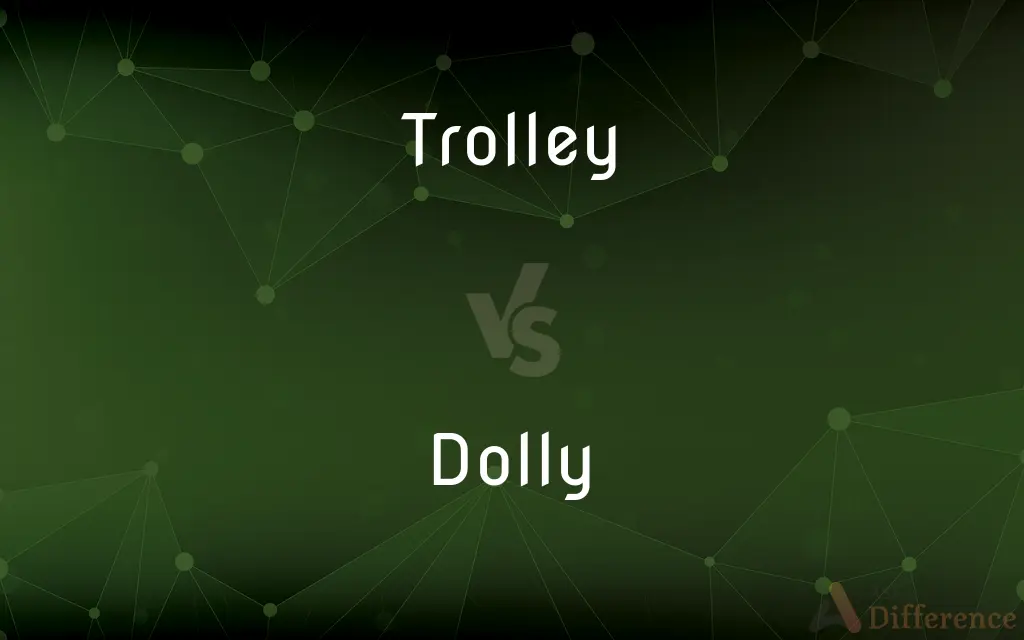Trolley vs. Dolly — What's the Difference?
By Tayyaba Rehman & Urooj Arif — Updated on March 22, 2024
Trolleys are wheeled carts for transport, while dollies are platforms with wheels for heavy items.

Difference Between Trolley and Dolly
Table of Contents
ADVERTISEMENT
Key Differences
A trolley is a wheeled vehicle or device, often used in various settings, including shopping centers, airports, and industrial sites, to transport goods, equipment, or people. Trolleys can range from simple hand-pushed carts to larger, more complex vehicles like those used in public transportation systems, such as trams or streetcars. On the other hand, a dolly is a platform on wheels, typically used for moving heavy or bulky items. Dollies are designed to be low to the ground and often have a flat surface, which makes it easier to load and unload heavy objects. They are commonly used in moving, warehousing, and film production to transport heavy equipment, boxes, or furniture.
While both trolleys and dollies serve the purpose of transporting items, their designs and uses differ significantly. Trolleys are more versatile in terms of the variety of goods they can carry and are often designed for specific environments, such as grocery stores or airports. Dollies, however, are more specialized tools focused on the transportation of heavy or bulky items, making them indispensable in situations where lifting and moving such items are required.
The use of a trolley often involves navigating through aisles, doors, and other public spaces, requiring a design that balances capacity with maneuverability. Dollies, being closer to the ground and typically used for heavier loads, are designed for stability and ease of loading, with some models featuring handles or straps to secure items during transport.
Maintenance and care for trolleys and dollies vary based on their construction and usage. Trolleys used in public or commercial settings may require regular cleaning and safety checks to ensure they are safe and hygienic for users. Dollies, especially those used in industrial or construction settings, may need periodic maintenance to ensure their wheels and loading surfaces are in good condition to handle heavy weights safely.
Comparison Chart
Definition
A wheeled cart or vehicle for transporting goods or people.
A platform on wheels for moving heavy or bulky items.
ADVERTISEMENT
Common Uses
Shopping, luggage transport, public transportation.
Moving heavy furniture, equipment, film production gear.
Design Features
Can be enclosed or open, multiple shelves or seating.
Typically a flat platform, low to the ground.
Load Capacity
Varies widely, from lightweight goods to multiple passengers.
Designed for heavy or bulky loads.
Maneuverability
Designed for easy navigation in public or commercial spaces.
Focused on stability with heavy loads, may have handles or straps.
Compare with Definitions
Trolley
A cart for transporting goods in stores or airports.
She loaded her groceries onto the trolley.
Dolly
A low platform on wheels for heavy items.
They used a dolly to move the refrigerator.
Trolley
A vehicle for public urban transportation.
We took the trolley downtown to avoid traffic.
Dolly
Hand trucks used in moving and deliveries.
The delivery person used a dolly to bring the packages upstairs.
Trolley
Often designed for specific environments and tasks.
The library trolley was filled with books for shelving.
Dolly
Essential in film production for moving equipment.
The camera was mounted on a dolly for the smooth tracking shot.
Trolley
Used for carrying luggage in hotels or airports.
The bellhop brought the luggage to the room on a trolley.
Dolly
Used for stability in transporting bulky objects.
The dolly made it easier to move the large potted plant.
Trolley
Can have specialized designs like a serving trolley.
The serving trolley was used to deliver room service.
Dolly
Can feature various designs for specific needs.
The furniture dolly was perfect for relocating the heavy couch.
Trolley
A large metal basket or frame on wheels, used for transporting heavy or large items, such as supermarket purchases or luggage at an airport or railway station.
Dolly
(Informal) A child's doll.
Trolley
A wheel attached to a pole, used for collecting current from an overhead electric wire to drive a tram.
Dolly
A low mobile platform that rolls on casters, used for transporting heavy loads.
Trolley
Short for trolleybus or trolley car
Dolly
Such a platform as used by one working underneath a motor vehicle.
Trolley
A streetcar.
Dolly
A hand truck.
Trolley
A device that collects electric current from an underground conductor, an overhead wire, or a third rail and transmits it to the motor of an electric vehicle.
Dolly
A wheeled apparatus used to transport a movie camera steadily along the ground or along a track.
Trolley
A small truck or car operating on a track and used in a mine, quarry, or factory for conveying materials.
Dolly
A movie shot made by a camera moving steadily on a dolly; a tracking shot.
Trolley
A wheeled carriage, cage, or basket that is suspended from and travels on an overhead track.
Dolly
A small locomotive, as for use in a railroad yard or on a construction site.
Trolley
Chiefly British A light cart designed to be moved by hand.
Dolly
A wooden implement for stirring clothes in a washtub.
Trolley
To convey (passengers) or travel by trolley.
Dolly
A tool used to hold one end of a rivet while the opposite end is being hammered to form a head.
Trolley
A trolley pole; a single-pole device for collecting electrical current from an overhead electrical line, normally for a tram/streetcar or a trolleybus.
Dolly
A small piece of wood or metal placed on the head of a pile to prevent damage to the pile while it is being driven.
Trolley
(US) A streetcar or light train.
Dolly
To move a dolly in a specified direction
The camera dollied left, keeping the actors in the frame.
Trolley
A light rail, tramway, trolleybus or streetcar system.
Dolly
A doll.
Trolley
A truck from which the load is suspended in some kinds of cranes.
Dolly
(cooking) A roughly cylindrical wooden object used as a base when molding pie crust.
Trolley
A truck which travels along the fixed conductors in an electric railway, and forms a means of connection between them and a railway car.
Dolly
A contrivance for stirring:
Trolley
A cart or shopping cart; a shopping trolley.
Dolly
A disc with downward legs and a vertical handle, used for agitating laundry.
Trolley
(British) A hand truck.
Dolly
A device turned on a vertical axis by a handle or a winch, giving a circular motion to ore being washed.
Trolley
(British) A soapbox car.
Dolly
A tool with an indented head for shaping the head of a rivet.
Trolley
(British) A gurney, a stretcher with wheeled legs.
Dolly
In pile driving, a block interposed between the head of the pile and the ram of the driver.
Trolley
(Philippines) A handcar.
Dolly
A small truck with a single wide roller used for moving heavy beams, columns, etc., in bridge building.
Trolley
To bring to by trolley.
Dolly
A small truck without means of steering, to be slipped under a load.
Trolley
To use a trolley vehicle to go from one place to another.
Dolly
A compact, narrow-gauge locomotive used for moving construction trains, switching, etc.
Trolley
To travel by trolley (streetcar, trolleybus or light train).
Dolly
(film) A specialized piece of film equipment resembling a little cart on which a camera is mounted.
Trolley
A form of truck which can be tilted, for carrying railroad materials, or the like.
Dolly
(slang) A young woman, especially one who is frivolous or vapid.
Trolley
A wheeled vehicle that runs on rails and is propelled by electricity;
`tram' and `tramcar' are British terms
Dolly
A fashionable young woman, one who follows the latest music or clothing fashions.
Dolly
A ball hit by a batsman such that it goes gently to a fielder for a simple catch.
Dolly
(gambling) A marker placed on the winning number by the dealer at roulette.
Dolly
(India) An offering of fruit or flowers.
Dolly
To hit a dolly.
Dolly
(transitive) To move (an object) using a dolly.
Dolly
(transitive) To wash (laundry) in a tub using the stirring device called a dolly.
Dolly
(transitive) To beat (red-hot metal) with a hammer.
Dolly
(transitive) To crush ore with a dolly.
Dolly
(Polari) Pretty; attractive.
Dolly
Left-handed (also dolly-handed, dolly-pawed, dolly-posh){{cite book
Dolly
A contrivance, turning on a vertical axis by a handle or winch, and giving a circular motion to the ore to be washed; a stirrer.
Dolly
A tool with an indented head for shaping the head of a rivet.
Dolly
In pile driving, a block interposed between the head of the pile and the ram of the driver.
Dolly
A small truck with a single wide roller used for moving heavy beams, columns, etc., in bridge building.
Dolly
A compact, narrow-gauge locomotive used for moving construction trains, switching, etc.
Dolly
A child's mane for a doll.
Dolly
Conveyance consisting of a wheeled support on which a camera can be mounted
Dolly
Conveyance consisting of a wheeled platform for moving heavy objects
Dolly
A small replica of a person; used as a toy
Common Curiosities
What makes a dolly suitable for heavy loads?
A dolly is suitable for heavy loads due to its sturdy construction, low center of gravity, and wheels designed to support and distribute the weight of the load.
Are there different types of dollies for specific tasks?
Yes, there are various types of dollies, including hand trucks, furniture dollies, and appliance dollies, each designed for specific moving tasks.
How does the design of a dolly contribute to its function?
The design of a dolly, with a flat platform and sturdy wheels, contributes to its ability to carry heavy loads with stability and ease.
How do you choose between a trolley and a dolly for a task?
The choice between a trolley and a dolly depends on the items being transported; trolleys are better for lighter, multiple items or people, while dollies are suited for heavy, bulky objects.
Can trolleys be used for transporting people?
Yes, certain types of trolleys, such as those used in public transportation (e.g., streetcars or trams), are designed to transport people.
Can dollies have features like handles or straps?
Yes, some dollies have handles for pushing or pulling, and straps to secure the load during transportation.
Can a dolly be used on uneven surfaces?
Some dollies are designed with larger wheels or special treads to be used on uneven surfaces, though it's always important to check the dolly's specifications for safe use.
What is the primary use of a trolley?
The primary use of a trolley is to transport goods or people, commonly seen in shopping centers, airports, and as part of public transportation systems.
What types of items are best moved with a dolly?
Heavy or bulky items, such as furniture, large appliances, and equipment, are best moved with a dolly.
What maintenance does a trolley require?
Trolley maintenance may include regular cleaning, checking for damage, and ensuring wheels and handles are functioning properly.
Are trolleys and dollies used in professional settings only?
While commonly used in professional settings, trolleys and dollies can also be useful in personal settings, such as home moves or DIY projects.
Do trolleys require any special operating skills?
Basic trolleys do not require special skills, but larger, motorized trolleys or those used in public transportation may require training or certification to operate.
Share Your Discovery

Previous Comparison
Elf vs. Hobbit
Next Comparison
Child vs. WardAuthor Spotlight
Written by
Tayyaba RehmanTayyaba Rehman is a distinguished writer, currently serving as a primary contributor to askdifference.com. As a researcher in semantics and etymology, Tayyaba's passion for the complexity of languages and their distinctions has found a perfect home on the platform. Tayyaba delves into the intricacies of language, distinguishing between commonly confused words and phrases, thereby providing clarity for readers worldwide.
Co-written by
Urooj ArifUrooj is a skilled content writer at Ask Difference, known for her exceptional ability to simplify complex topics into engaging and informative content. With a passion for research and a flair for clear, concise writing, she consistently delivers articles that resonate with our diverse audience.















































